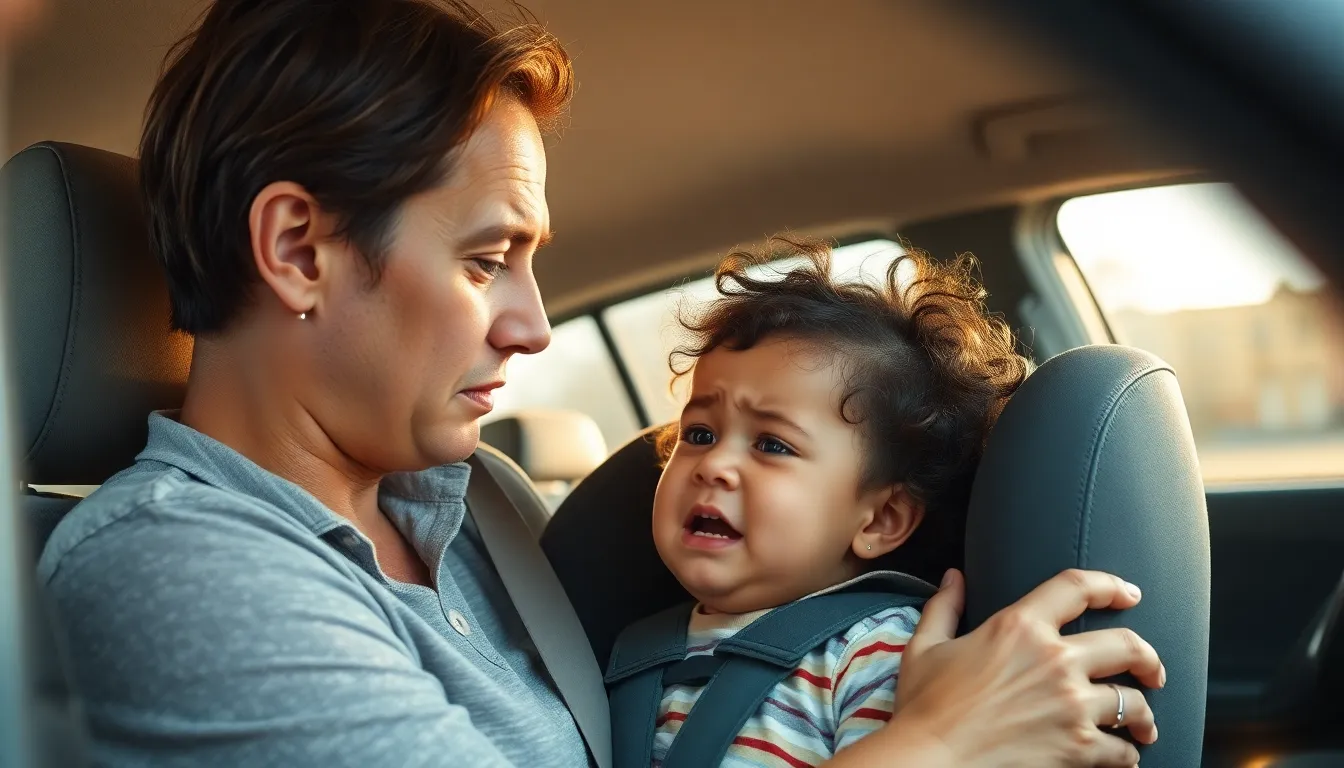Motion sickness in toddlers under 2 can feel like a rollercoaster ride—without the fun part. Picture this: a sweet little one, giggling in the backseat, suddenly turning green as they experience the not-so-joyful side of travel. For parents, it’s a race against time to figure out what’s causing the chaos. Is it the bumpy roads? The too-fun toys? Or maybe it’s just their little bellies protesting the adventure?
Understanding motion sickness in toddlers is crucial for keeping family outings enjoyable. It’s not just about avoiding the dreaded car seat vomit; it’s about ensuring little ones can explore the world without feeling like they’re on a never-ending tilt-a-whirl. With a bit of knowledge and some clever strategies, parents can help their tiny travelers conquer the ups and downs of motion sickness, turning potential meltdowns into laughter-filled journeys.
Table of Contents
ToggleUnderstanding Motion Sickness
Motion sickness occurs when the brain receives conflicting signals from the eyes, inner ear, and body during movement. Toddlers under 2 years old frequently experience this condition, especially during travel in cars, buses, or airplanes.
What Is Motion Sickness?
Motion sickness refers to a condition where sensory signals misalign, leading to discomfort during movement. When a toddler rides in a vehicle, their inner ear senses motion while their eyes may focus on stationary objects inside the car. Such conflicting information can trigger symptoms and distress.
Symptoms of Motion Sickness in Toddlers Under 2
Common symptoms include crying, vomiting, and restlessness during travel. Parents may notice their toddler becoming unusually quiet or fidgety. Excessive drooling and loss of appetite may also occur. Identifying these signs early helps parents take action to alleviate discomfort, ensuring a smoother journey for everyone involved.
Causes of Motion Sickness in Toddlers Under 2

Understanding the causes of motion sickness in toddlers under 2 helps parents address symptoms effectively. This condition arises from a mix of developmental factors and environmental triggers.
Developmental Factors
Toddlers’ sensory systems are still maturing. The inner ear, responsible for balance, often struggles to process movement signals. Vision also plays a role; children might focus on nearby objects while failing to recognize vehicle motion. This miscommunication between the body and brain leads to discomfort. As toddlers grow, their ability to process these signals improves, reducing motion sickness episodes.
Environmental Triggers
Certain environments contribute to motion sickness in young children. Bumpy roads or sudden stops are common triggers during car rides. Close quarters in buses or airplanes can heighten anxiety, making symptoms more likely to surface. Additionally, bright lights and loud noises from the environment can overwhelm toddlers, causing distress. Keeping journeys calm and minimizing distractions can help alleviate these environmental triggers, leading to a more enjoyable travel experience.
Managing Motion Sickness in Toddlers
Managing motion sickness in toddlers involves identifying triggers and implementing effective strategies. Parents can take several approaches to alleviate symptoms and make travel more enjoyable.
Preventive Measures
Selecting the right time for travel can significantly impact a toddler’s comfort. Traveling during sleep times often helps as the child may remain asleep throughout the journey. Keeping the vehicle well-ventilated minimizes feelings of nausea. Offering simple distractions, such as toys or favorite music, can capture a toddler’s attention and lessen awareness of the motion. Furthermore, ensuring that the child faces forward in the car seat stabilizes their sensory experience. Choosing smoother routes when possible avoids sudden jolts that might trigger discomfort.
Treatment Options
Using ginger-based products, such as ginger snaps or ginger tea, might ease nausea for some toddlers. For immediate relief, parents can practice deep breathing techniques with their child, promoting relaxation. In certain cases, over-the-counter medications designed specifically for toddlers may be considered. Consulting a pediatrician before administering any medication is vital for safety. Keeping a ready supply of wipes helps manage any unexpected symptoms, such as vomiting or drooling. Additionally, staying calm and reassuring during episodes of motion sickness supports the toddler emotionally.
Tips for Parents
Understanding motion sickness in toddlers can lead to better management strategies. Parents can adopt specific approaches to alleviate symptoms during travel.
Recognizing Early Signs
Identifying early signs of motion sickness helps parents take preventive measures. Symptoms like excessive drooling or fussiness often appear first. Crying during travel usually indicates discomfort or nausea. Observing changes in appetite can also signal onset of motion sickness. Noticing restlessness in the car reinforces the need for intervention. Parents can maintain vigilance for signs of distress, allowing for timely responses.
Helpful Strategies During Travel
Using helpful strategies during travel minimizes the risk of motion sickness. Traveling during nap times promotes restful journeys for toddlers. Ensuring good ventilation keeps the environment comfortable and reduces nausea. Toys and music serve as effective distractions from discomfort. Parents should keep toddlers facing forward in car seats for stability. Opting for smoother routes lessens the likelihood of triggering symptoms. Being prepared with ginger-based products can aid in alleviating nausea. Remaining calm and reassuring fosters a positive atmosphere for the child.
Navigating motion sickness in toddlers under 2 can be challenging for parents. By understanding the triggers and symptoms, they can implement effective strategies to ease their child’s discomfort. Creating a calm and supportive environment during travel is crucial for both the child’s well-being and the family’s enjoyment. With the right preparation and awareness, parents can transform travel experiences into positive memories. Prioritizing their toddler’s comfort and recognizing early signs of motion sickness will go a long way in ensuring smoother journeys.




